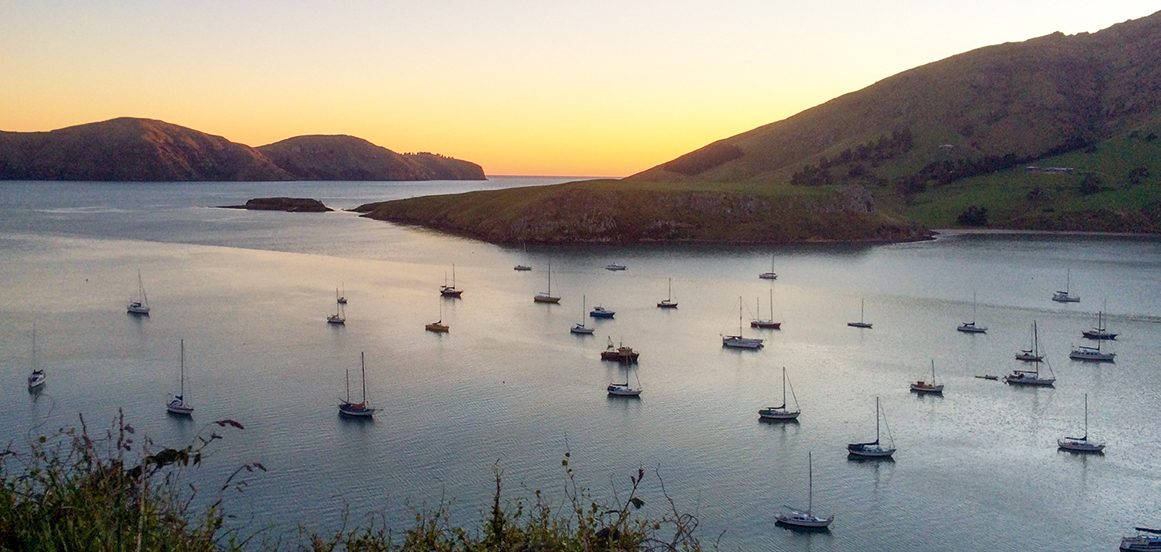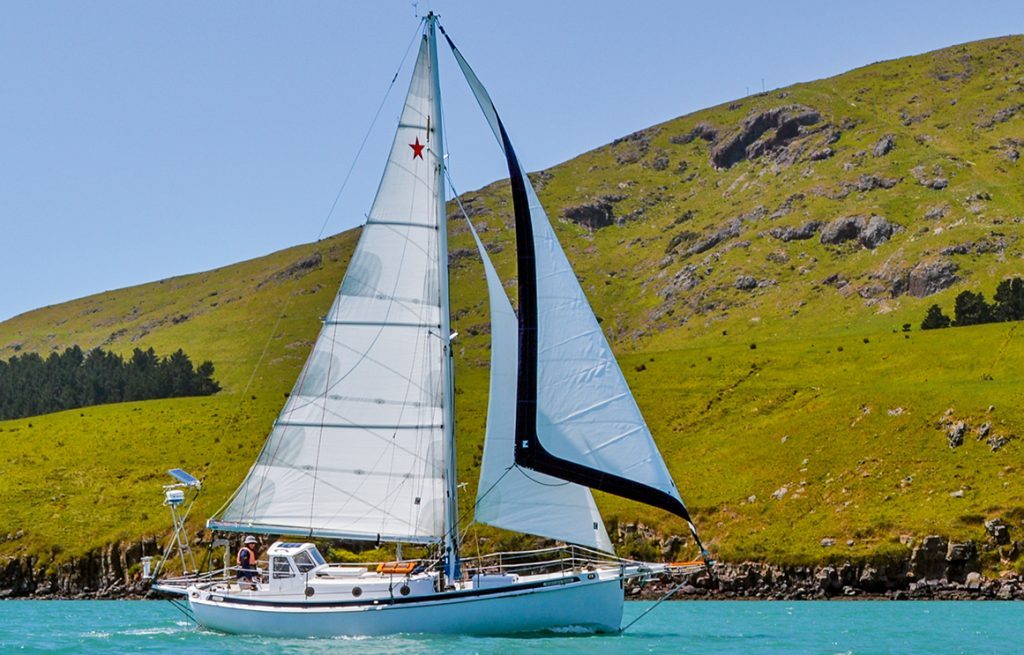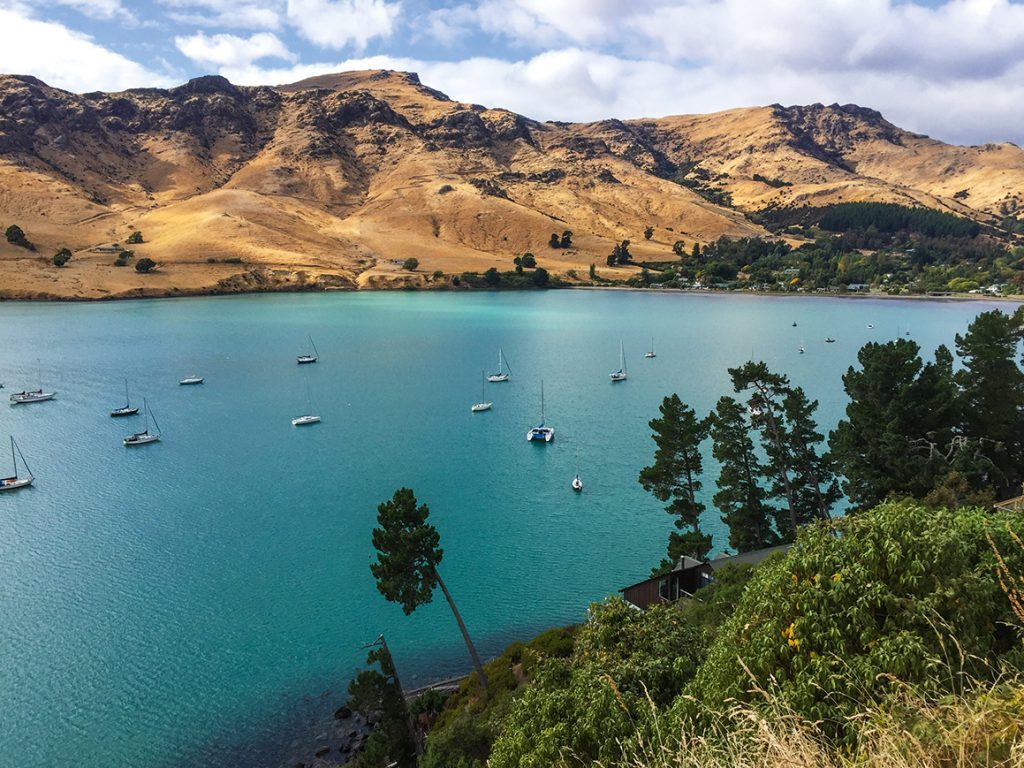

Our yacht Whitney Rose lies in a bay far from the nearest marina. Well-protected, it has a pleasant aspect, an attractive swimming beach, an assortment of cruising yachts – and an eclectic gallery of owners. Story by Matt Vance.
The bay attracts a variety of modest, well-built cruising boats. The sailors, like the boats, are modest and full of character, with a roundedness that all objects sloshed in saltwater seem to take on overtime.
They have made livings as farmers, builders and wharfies, working with their hands on their boats and on their lives. Like most people they have their dreams, but unlike their landlubber friends these dreams have names like Carly, Astra, or Rhapsody.

The boats are double-ended, plumb-bowed, fractional–rigged, gaff-rigged – ketches, sloops, schooners, catamarans and keelers – made from timber, steel, fibreglass and concrete. Some are immaculate works of art that show your reflection in the hull, others are rough as guts, neglected, with guano-covered decks and large skirts of seaweed burgeoning from their underwater sections.
The owners proudly defend their boats’ attributes as if they were their children, turning a blind eye to the eccentricities and errant behaviour of their offspring. As is said of dog owners, over time their personalities begin to fit their boats.
Occasionally a new boat will turn up in the bay and the very look of the boat will sometimes lead me to unfounded conclusions like “He’s definitely a Wharram catamaran sailor with socks, sandals, a beard and two girlfriends” or “It’s that bogan welder and his steel schooner with a chain-link steering wheel”.
That is until I row over in the dinghy and meet them, get invited aboard for a cup of something and discover they are a barefoot clergyman or a solo dad. When they ask if I would like sugar with my tea and top it up with rum I know they will fit in just fine. The boats in the bay are held apart from ours by their moorings of chain and rope but somehow this holds us together and these people become our friends.

Very rarely is a second name used to describe these people. It is usually Jim from Juneer or Robbie from Cabot. Their boats become part of their name as if their whole identity has been swallowed by the bay. It is at their funerals you realise that sailing is only part of their life.
Hearing of this other life has a whiff of betrayal to it, and I find myself saying things like “Who would have guessed the old bugger was a devout Christian?” and subconsciously ignoring all of that and preferring the memory of them as a sailor who had an immodest enthusiasm for gin and ribald jokes.
Among the sailors in the bay, I am the youngest by about 100 years, yet it never seems to matter out there – I just fit right in. Occasionally a description like Jim from Juneer is not enough. Some of the old fellows look at you blankly and you have to resort to descriptions of their boat. “You know, that beautiful steel cutter with the teak trim…”
“Oh yes, Jim,” they will say, the boat being a suitable description to cover everything from Jim’s anatomy to his psychological makeup.
Like any collection of boats in the world, the ones in the bay are subject to the 90/10 rule. This is the quirk of human nature that says 90% of the boats are rarely ever sailed. Some of these are taken out of the water for inspiration, vision and antifouling once a year to keep them afloat. Compounding this is fear: the fear of actually getting out there and handling the boat and the fear of what you might discover when the sea finds you out.

Among the 10% of boats that actually sail, there are other subspecies. Most notable of these are the boats of the tinkerers. These are the sailors who don’t necessarily enjoy sailing but enjoy boats. They keep their boats in immaculate condition. “You could eat your dinner off that” is an expression you will often hear of their handiwork.
They love getting lost in the detail of diesel engine installation and the labyrinth of electronic gadgetry that their boats seem to propagate. To step aboard and offer a simple “How’s it all going?” will elicit a detailed analysis of their compression test or moisture content of the hull that only more sugar in the tea will render interesting.
As is their nature, tinkerers love to build boats and will spend a casual 20 years getting the details right. Getting the boat to the water is perhaps the greatest of life’s disappointments for the tinkerer.
The actual sailors are a small minority – probably only half of the 10% of those that are aboard their boats regularly. They are distinguished by their ability to handle their boats under sail and have been over the horizon in them. Their boats are in working condition, well-loved and sailed, but you probably could not eat your dinner off them.
Occasionally the bay plays out some drama. There are the fugitives who move onto their well-neglected boat to avoid the bailiff, or the ex-wife, or the law. They keep a low profile and tend only to come ashore in the hours of darkness. Occasionally the bailiff, or the ex-wife, or the law catches up with them and they disappear for a year or five.

Other than these fugitives there is always a liveaboard or two in the bay. Some of these like Steve from Torea have land jobs and occasionally disappear for a couple of years as they circumnavigate the Pacific in their well-found boats, others tend to see their vessel as a flophouse and accumulate on deck a pile of junk that threatens to swamp their well-neglected craft.
On the row out to the moorings from the wharf it is common to stop and chat with other sailors on the way. Mostly these conversations are had as you rest on the oars holding station while you discuss the finer points of sail trim or new and innovative ways of deterring the birds and their propensity to shit all over your boat while you are absent.
The topics of conversation are always broad, welcoming and full of good humour. Some seem to enjoy this socialising more than others and it is not uncommon to have a few of the older fellows never actually make it to their own boats after gamming away the afternoon going from boat to boat.
The dinghy ramp and the wharf is another area you are likely to get into a conversation – and it never pays to be in a rush. When I am, I feel like I have cheated myself out of something money can’t buy.

The wharf usually contains a collection of dockside loafers, swimmers and fishermen who for the most part exchange pleasantries about the weather and such. Occasionally one of them will make a disparaging mark about Spud (our Phil Bolger-designed tender). They will say things like “Is that a coffin?” or “How can you tell which end is the front?”
On one notable occasion, Walter of Trailblazer almost fell out of his dinghy as he came alongside the wharf while the local female hippie contingent was indulging in a nude swim. He quickly gained his composure before singling out one young lady about to take the plunge. In his rich Irish accent he said, “You’ll catch your death of cold dressed like that, young girly.” Like I said it never pays to rush home from the wharf.
It is not until you have been away a while that you realise how good it is here. When we gybe over for the last time in Whitney Rose and swoop into the bay under the reassuring presence of Mt Evans it is like returning to the 1950s when time and money meant different things.
As we sail through the moored yachts and wave at the sailors who have become their boats, we come as close as we can to putting our finger on the thing that makes this quiet bay magic




